Teaching students to play rhythms accurately may require a variety of approaches. Some students possess natural rhythmic ability, while others may have little sense of internal rhythm and require a great deal of patience and creativity from their teacher. As a flute teacher for all levels, including beginners in a group setting, I am continually developing strategies to help students learn more complicated rhythms in a fun way.
All students should have a strong rhythmic foundation. The following techniques can serve as a basis for teaching concepts, as well as review and remedial work with students. Teachers should teach skills that promote independence. Give students the tools so they can decode rhythms on their own. With patience, a variety of explanations, and repetition, most students will have an aha moment and truly understand at some point.
Some students respond to quantitative explanations involving fractions, using some sort of diagram or pie chart.
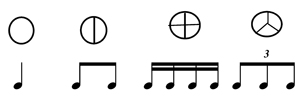
1 quarter =1 beat 2 8ths = 1 beat 4 16ths = 1 beat 3 triplets = 1 beat
 Other students respond to traditional methods of counting rhythms. Foot tapping to a steady beat with evenly spaced down and up movements helps with note values that are divisible by two. In the following example, the down arrows fall on the beat numbers and the up arrows on the and of the beat (the upward stroke of the foot). Foot tapping also introduces a gross motor (large muscle) element into the counting, which is helpful for students who are tactile learners.
Other students respond to traditional methods of counting rhythms. Foot tapping to a steady beat with evenly spaced down and up movements helps with note values that are divisible by two. In the following example, the down arrows fall on the beat numbers and the up arrows on the and of the beat (the upward stroke of the foot). Foot tapping also introduces a gross motor (large muscle) element into the counting, which is helpful for students who are tactile learners.
.jpg)
The basics of subdivision and counting notes with rhythmic values less than one can be a challenge to teach. Rhythm words that replicate rhythms can help students count rhythms with eighth notes, sixteenth notes, triplets and other note values smaller than one beat. I have several students who have great difficulty with traditional counting, but are able count rhythms quite accurately using rhythm words such as
![]()

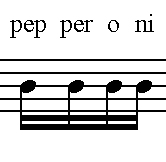
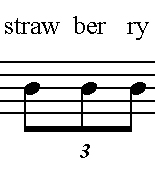
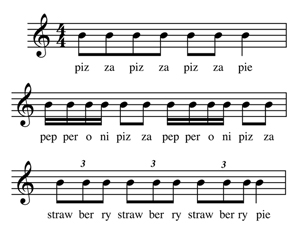
Even with more complex combinations of rhythms, many students find success using rhythm words. Teachers and students can create their own word combinations for rhythms or use the examples below.

.jpg)

Dotted Rhythms
Traditional ways of counting dotted rhythms may leave students confused or learning the rhythm by rote without understanding. As a teacher, I have found myself abbreviating explanations to long – short which gives a short term, quick fix, but does not help students decode the rhythm in the future.
One of the most effective methods to teach students to play dotted quarter and eighth rhythms accurately is to ask them, how many eighth notes are in a dotted quarter? If they have difficulty answering, explain that the dotted quarter is the same as a quarter, plus half the value of a quarter (i.e. an eighth note). Then ask, “How many eighth notes are in a quarter note?” As you work through the answers to these questions with the student, write down the following:
Dotted quarter = quarter + eighth = eighth + eighth + eighth
This looks very mathematical, which will appeal to some students and scare others. Explain that a dotted quarter equals three eighth notes and can be counted by saying (or thinking) eighth eighth eighth. To find the speed of the eighth note, have them tap their foot down and up evenly to the desired tempo, thinking down-up, down-up, down-up, down-up as was done for quarter notes earlier. This divides the quarter into eighths, one for the down and one for the up. Counting the dotted eighth and eighth rhythm will become eighth-eighth-eighth and.
The type of explanation also works for dotted eighth and sixteenth rhythms.
Dotted eighth = eighth + sixteenth + sixteenth + sixteenth
When students understand the subdivisions they are ready to use words. The rhythm is eventually counted

Counting Tuplets
Rhythm words can also be used for odd-numbered tuplets. Traditional methods of counting odd-numbered tuplets have the student dividing the number of notes roughly in half, with the smaller number on the down-beat and the larger number on the up-beat.
For example, 5-tuplet notes are played 2 + 3, and 7-tuplet notes are played 3 + 4.
.jpg)
Using words makes these rhythms easier and less intimidating to many students. For 5-note tuplets try: Philadelphia, university, or hippopotamus. Any five syllable word will do. Possible words for 7- note tuplets are: autobiographical or peanut butter sandwiches.

Tuplets with even numbers, such as 6-note tuplets, are usually easier to understand because the same number of notes are played on the down-beat and on the up-beat. Thinking of 6-note tuplets as a twice-as-fast triplet is helpful to some students. Three notes are played on the down-beat and three notes played on the up-beat and can be counted 1-2-3 1-2-3. I generally use the rhythm word: dee-dle-dee dee-dle-dee, but any six syllable word works.
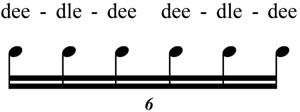
There is a lot of room for creativity in teaching rhythms. Creating rhythm words for particular students or specific to your area can be fun. Use students’ names, food, local cities, schools, sports teams, universities, or shopping malls. Be creative and flexible in designing lessons to help your students understand rhythms.






